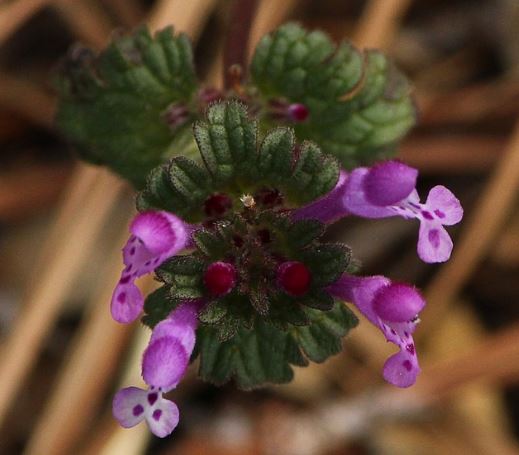
Henbit weed is a typical annual weed that grows in most parts of the United States. It can be very difficult to get rid of once it has gotten into your lawn. Henbit weed not only benefits from moist areas where your lawn may be a little sparse, but each plant is very likely to take root and ruin your life if you don’t take action.
Don’t worry, we can tell you exactly what you must do to keep henbit weed under control.
Table of Contents
What Is Henbit?
Description
Henbit weed (Lamium amplexicaule) is a sparsely hairy, winter annual weed with greenish to purplish, tender, square stems. The opposite leaves of this plant have broad egg-shaped shapes, bluntly toothed margins, and noticeable veins on the underside. Lower leaves have petioles, while the upper leaves are sessile (affixed directly to the stem). It can grow up to 16 inches tall and has a fibrous root system. The distinctive henbit flowers are reddish-purple with darker spots on the lower petals. It blooms in the spring, with the flowers arranged in whorls in the upper leaves.
Henbit weed has square, green, or purple stems and sparsely-haired leaves. In the middle of spring, henbit weed blooms with recognizable reddish-purple, orchid-like flowers. The flowers are formed in whorls at the top of the stems and have a white face and a dark red spot on the lower petal.
The Henbit Lifecycle
Henbit weed is regarded as a seasonal annual. Henbit weed seeds germinate in the late summer or early autumn. The young seedlings will grow during any brief warm spells throughout the winter and then go dormant when the weather cools again. Henbit weed will grow quickly and become noticeable on the lawn once the weather warms up in the spring. The flowers begin to bloom in mid-spring. When the early summer temperatures start to rise, the henbit plant then produces seeds before dying.
Henbit Look-alikes
Henbit weed and purple deadnettle are frequently confused. In contrast to the upper leaves of henbit weed, purple deadnettle has triangular leaves with petioles that are clearly red or purple-tinged. Additionally, it is frequently confused with creeping Charlie (also known as ground ivy). Creeping Charlie, in contrast, is a very aggressive perennial weed.
How To Prevent Henbit Weed In The Lawn?
Grow a thick lawn so that weeds have no space to grow as a good defense against future henbit issues. Feeding your lawn four times a year ensures that it receives the nutrients it needs to grow thick and strong, leaving little room for henbit weed.
Mowing your lawn at the appropriate height encourages the growth of thick, deeply rooted grass that can outcompete weeds.
Prior to its flowering, henbit weed must be located and eradicated. As a result, the plants won’t produce or release seeds. If you wait until after it blooms, you might have to deal with it for several years.

How To Control Henbit weed In Hardscapes?
To kill and prevent henbit weed from popping up in cracks in sidewalks or a paver patio using Ortho GroundClear Vegetation Killer Ready-To-Use2. When used according to label instructions, it eliminates existing weeds and prevents the germination of new ones for up to 12 months. Use Ortho’s GroundClear Super Weed & Grass Killer to effectively eradicate almost any henbit weed, including henbit. It kills weeds and their roots quickly and thoroughly.
Cultural Control
Henbit weed is a winter annual broadleaf weed that reproduces by seed that germinates in the fall or winter. Whenever it is warm outside in the winter, henbit grows. It is mostly dormant during the winter, with the exception of a few unusually warm spells. In the spring, henbit resumes growth, produces seed, and then perishes as temperatures rise in the late spring and early summer.
Particularly in areas with excessively moist soil, henbit weed can quickly invade thin turf areas. Additionally, shade promotes growth. Plants are not significantly impacted by mowing because of their potential prostrate growth habit.
The best defense against henbit invasion is a thick, healthy turf. Before properly fertilizing, mowing, and watering to promote dense growth, choose a turfgrass cultivar that is adapted to your region. When watering the lawn in the fall, water it deeply but sparingly because weed seeds need moisture on the soil’s surface to germinate. For more information on growing healthy turfgrass.
Henbit weed can be manually dug out of flower beds and mulched to keep it from growing. For reducing weed growth, a 3-inch mulch layer is ideal.
Chemical Control
Before using herbicides to control henbit weed, cultural controls should be put in place. To further reduce a henbit population, however, chemical control might still be required after changing lawn care procedures. Herbicides should be carefully selected based on the type of turf and all label directions should be followed. For best results, chemical henbit controls should be applied in the late fall or early spring. Remember that as weeds get older, herbicide effectiveness declines.
Now henbit weed in your lawn will never trouble you.